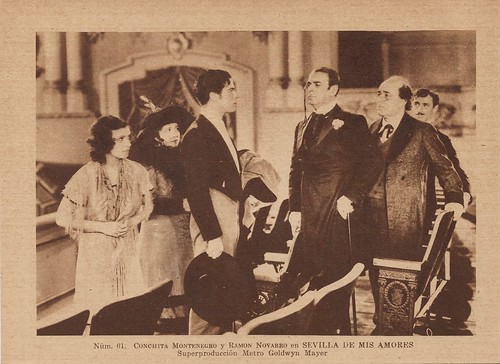
Spanish collectors card by Editorial Grafica Barcelona in the Estampas del cinema series, no. 57, series 8, 1931, no. 1 of 8. Photo: Metro-Goldwyn-Mayer. Conchita Montenegro and Ramon Novarro in Sevilla de mis amores (Ramon Novarro, 1931).

Spanish collectors card by Editorial Grafica Barcelona in the Estampas del cinema series, no. 58, series 8, 1931, no. 2 of 8. Photo: Metro-Goldwyn-Mayer. Conchita Montenegro in Sevilla de mis amores (Ramon Novarro, 1931).

Spanish collectors card by Editorial Grafica Barcelona in the Estampas del cinema series, no. 59, series 8, 1931, no. 3 of 8. Photo: Metro-Goldwyn-Mayer. Ramon Novarro and Rosita Ballesteros in Sevilla de mis amores (Ramon Novarro, 1931).

Spanish collectors card by Editorial Grafica Barcelona in the Estampas del cinema series, no. 60, series 8, 1931, no. 4 of 8. Photo: Metro-Goldwyn-Mayer. Ramon Novarro in Sevilla de mis amores (Ramon Novarro, 1931).
Peering over the convent wall to the cantina
Sevilla de mis amores/La Sevillana (1930) marked Novarro's first performance in Spanish, his first language. Ramon Novarro plays Juan de Dios, a young Spaniard from a poor working-class background. Juan is a cantina performer in Seville, singing and dancing with his partner Lola (Rosita Ballesteros). They have a contentious professional and personal relationship. She is jealous and cannot tolerate his constant flirting.
Juan aspires to become a serious opera singer, under the tutelage of Estaban (José Soriano Viosca). Once the greatest impresario in Spain himself, Estaban lost everything because of the same reckless behaviour that Juan now exhibits. Estaban is trying to quell that behaviour in Juan.
Estaban's plan is to get one of his old contacts in Madrid, an impresario (Michael Vavitch), to manage Juan's career to get him serious singing gigs, leading to that fame and fortune Esteban once used to have. It's love at first sight when Juan meets Maria Consuelo Vargas (Conchita Montenegro).
What he initially doesn't know is that their meeting was by no accident, as she, a postulant at St. Agustín convent who just escaped from that life, had been mesmerised by him and his singing every time she saw him as she peered over the convent wall to the cantina. As she tells him that she has no home, he takes her in.
When Juan learns that Maria Consuela used to be a nun in training, he has to decide whether to marry her as is his wont or try to get her back to the convent. Factored into his decision may be her brother, Army Captain Enrique Vargas (Martin Garralaga), who believes she is destined to be married to God, jealous Lola, and his and Estaban's own aspirations for his singing career.
The plot was based on a story by Dorothy Farnum. The art direction was by Cedric Gibbons, cinematography by Merritt B. Gerstad. The film cost $103,437 and had its American release at the Teatro Califórnia Internacionale in Los Angeles on 5 December 1930, and its Spanish premiere in Barcelona, on 4 April 1931. Sevilla de mis amores (1930) and Le chanteur de Séville (1931) were filmed using a different crew and supporting cast on the same sets at MGM Studios as Call of the Flesh (1930). A German-language version, also to be directed by Novarro, was never filmed for financial reasons.
Sevilla de mis amores (1930) is credited with boosting the career of the then 19-years-old Conchita Montenegro. Novarro's mother, Leonor Pérez Gavilán de Samaniego, makes her only film appearance as Mother Superior of the convent. Ramón Guerrero, who appears in the film, translated the original screenplay, and Novarro translated the song lyrics, assisted by Herbert Stothart.

Spanish collectors card by Editorial Grafica Barcelona in the Estampas del cinema series, no. 61, series 8, 1931, no. 5 of 8. Photo: Metro-Goldwyn-Mayer. Ramon Novarro and Conchita Montenegro in Sevilla de mis amores (Ramon Novarro, 1931).

Spanish collectors card by Editorial Grafica Barcelona in the Estampas del cinema series, no. 62, series 8, 1931, no. 6 of 8. Photo: Metro-Goldwyn-Mayer. Ramon Novarro and Conchita Montenegro in Sevilla de mis amores (Ramon Novarro, 1931).

Spanish collectors card by Editorial Grafica Barcelona in the Estampas del cinema series, no. 63, series 8, 1931, no. 7 of 8. Photo: Metro-Goldwyn-Mayer. Rosita Ballesteros and Conchita Montenegro in Sevilla de mis amores (Ramon Novarro, 1931).

Spanish collectors card by Editorial Grafica Barcelona in the Estampas del cinema series, no. 64, series 8, 1931, no. 8 of 8. Photo: Metro-Goldwyn-Mayer. Ramon Novarro in Sevilla de mis amores (Ramon Novarro, 1931).
Sources: Wikipedia and IMDb.
No comments:
Post a Comment